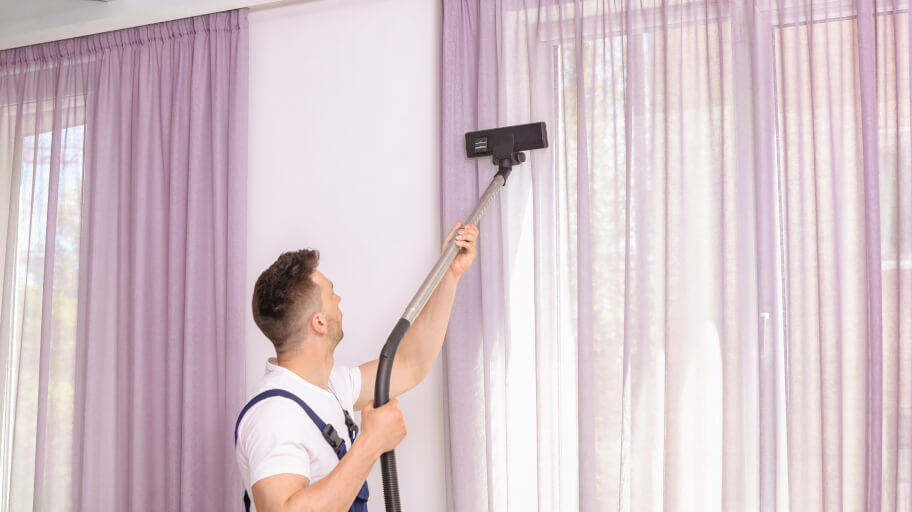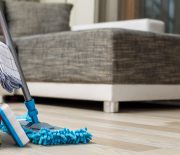Last update: 3 months ago

Curtain cleaning can be quite a hassle, especially if your window treatments are difficult to remove from their rods. Regardless of how spotless you maintain your home, they accumulate dust, dirt and allergens over time. It’s essential to wash them regularly, not only for hygiene purposes but also to preserve their aesthetic appeal. Regular curtain cleaning ensures good indoor air quality and enhances your living spaces’ overall cleanliness and attractiveness.
Fortunately, there are easy and effective methods to clean your curtains without the need to take them down. You can achieve remarkable results by utilising standard household tools, simple cleaning solutions, and the proper techniques.
So, if you:
- Are looking for a quick and easy way to clean your curtains;
- Want to know the most hassle-free way to maintain their condition between deep cleaning sessions;
- Not sure how to treat different types of fabrics.
This comprehensive curtain cleaning guide will walk you through the entire process step-by-step. Additionally, we’ve gathered expert maintenance tips from our curtain cleaning practice in Australia.
Assessing curtain material and type
Let’s start with assessing the fabric of the curtains. This is important as some curtains can be prone to shrinkage or discolouration and may require special care. This step will ensure the longevity and appearance of your window decor investment.
Here are the most common curtain fabrics and their recommended care requirements:
- Polyester – These curtains can be prone to static or pilling if not cared for properly. Regular gentle cleaning is recommended.
- Cotton – Cotton curtains have the potential to shrink or wrinkle. Avoid high heat when cleaning to minimise the risk of damage.
- Linen – Delicate curtains that may wrinkle easily and require gentle handling. Stubborn stains on linen fabrics may need professional cleaning.
- Silk – Silk curtains are highly delicate and require special care. Dry cleaning is recommended to avoid damage and discolouration.
- Blends – The cleaning method for blended curtains depends on the specific combination of materials. For example, lace curtains, which are often a blend of fabrics, should be cleaned gently to protect the delicate lace patterns. Avoid harsh detergents or excessive agitation.
Refer to the manufacturer’s labels to determine the specific fabric of your curtains and to find the appropriate care requirements. Furthermore, it’s advisable to perform a fabric test on an inconspicuous area of the curtain, such as the hem or the back, to prevent any potential damage or discolouration of these valuable items.
Tools needed for cleaning curtains
Once you’ve assessed the specifics of your curtains, it’s time to gather the tools and equipment you’ll need for the cleaning.
Here is a list of items to have on hand to tackle the process effectively and efficiently:
- Vacuum cleaner with adjustable power or a handheld vacuum cleaner (preferably with a HEPA filter and upholstery or soft brush attachment)
- Ladder or a step
- Lint roller or brush
- Microfibre cleaning mitt or cloth
- Sponge
- Dish soap or mild cleaning detergent
- Steam cleaner with an upholstery attachment (optional for deeper cleaning)
- Isopropyl alcohol (optional, for stubborn dirt and carbon deposits)
- White vinegar (optional)
- Dry cleaning sheets (optional)
Methods for cleaning different types of curtains without taking them down
There are different methods you can apply to clean your curtains without taking them down based on their type, fabric, and considering if they are lightly dusty or heavily soiled. The general approach will depend on whether you are dealing with sheer curtains or heavy drapery.
Sheer curtains, being lightweight and delicate, can often be freshened up using gentle techniques, while heavy drapery may require more thorough cleaning methods. You can also apply a single cleaning technique or combine multiple techniques with different intensities to achieve optimal results.
How to clean sheer curtains without removing them from their rods
Sheer curtains are typically made from materials such as chiffon, voile, or lace. They require careful handling during the cleaning process. Here are the techniques that can be applied individually or in combination to clean them effectively:
- Vacuuming.
Use a ladder or a step to reach the top of the curtains. Place the upholstery attachment to the vacuum cleaner and set it to low power. Start vacuuming from top to bottom with gentle downward motions. The brush part of the attachment will effectively loosen and remove dust and dirt from the fabric.
- Lint rolling.
If you notice any remaining pet hair or lint particles on the sheer curtains after vacuuming, use the lint roller or brush to remove them further. You can also use the soft brush attachment of the vacuum cleaner for this purpose. - Spot cleaning.
Once the dust and lint have been removed, it’s time to treat the stains, if any. Begin by blotting the stained area with a wet sponge dipped in a solution of equal parts white vinegar and water. Allow the solution to work for a while, then gently rub the stain. Be careful not to tear or stretch the fabric. Blot the area again with a clean wet sponge and leave it to dry.
For stubborn stains, you can use a dry cleaning sheet specifically designed for delicate fabrics. Follow the instructions provided in the product’s manual and repeat the process if necessary.
- Steam-cleaning.
It’s an excellent option for both cleaning and refreshing curtains. It’s crucial to use an upholstery attachment and select a gentle setting to avoid damaging the fabric. As mentioned earlier, certain materials may be prone to shrinkage or wrinkling. Begin steam-cleaning the curtains from top to bottom, ensuring you are covering every part. The power of steam will effectively dislodge stains and dirt. Let the curtains air dry, providing good ventilation in the room. - Deodorising.
This is a vital step in curtain cleaning that guarantees a fresh feeling and overall satisfaction with your curtains. In the detergent section of your local store, you can find specialised upholstery deodorisers and fabric freshener sprays. Select a scent that appeals to you and evenly spray it over the curtains, starting from the top and working your way down. Be careful not to over-apply, as certain scents can be overpowering and may potentially cause discomfort to your sense of smell, which may disrupt your sleep, for instance.
How to clean heavy drapes without removing them from their rods
Heavy drapes are typically made from thicker and more robust materials such as velvet, brocade, or upholstery fabrics. They can accumulate more dust and odours compared to sheer curtains. Depending on the condition of your heavy drapes, apply one or more of the following curtain cleaning techniques:
- Vacuuming.
Similar to sheer curtains, begin vacuuming from top to bottom. You can use a regular vacuum cleaner with an upholstery attachment, as the sturdier fabric can withstand it. Make sure to cover the entire surface of the drapes thoroughly. - Lint rolling.
After vacuuming, use a lint roller or brush to remove any remaining tiny fibres or lint particles from the drapes. Roll the lint roller or brush over the surface to capture and remove the unwanted debris. - Spot cleaning.
Follow the same spot-cleaning process as mentioned earlier for sheer curtains. Begin by blotting the stained area with a solution of white vinegar and water. Before applying the solution, it’s advisable to test it on a hidden area of the fabric to ensure it won’t cause any damage. For stubborn stains, use a dry cleaning sheet designed for heavy materials. - Wiping down.
Once you’ve treated any stains, you can proceed to wipe down the entire drapes. Prepare a solution by mixing 5 litres of water with a teaspoon of dishwashing detergent. If you’re dealing with pollution contaminants or carbon deposits due to heavy traffic in your area, add 50ml of isopropyl alcohol to help loosen and remove them. Dip a microfiber cleaning mitt or cloth into the solution. Make sure it’s wet enough to dislodge any remaining dirt.
Wipe the drapes down section by section until the entire surface is clean. Wash the cleaning mitt frequently in the solution to maintain its effectiveness. Allow drapes to air dry completely. - Steam-cleaning.
This is a highly effective method for cleaning and refreshing thick natural fibre or polyester curtains. However, it’s important to check the manufacturer’s recommendations beforehand, as the high steam temperature can potentially damage certain fabrics. Additionally, if your drapes have a lining, consider its specifications as well.
Begin steam cleaning from the top and work your way down, covering the entire surface of the drape. Ensure good ventilation in the space until they are completely dry. - Deodorising.
Heavy drapes tend to retain odours more than lighter curtains, making regular refreshing and deodorising crucial for maintaining a pleasant-smelling environment in your home. Apply fabric freshener or deodorising upholstery spray evenly over the surface of the drapes, following the instructions provided by the manufacturer. This will effectively eliminate any lingering odours and keep your heavy drapes smelling fresh.
Tips and tricks for maintaining clean curtains between washes
While regular cleaning of the curtains is necessary to keep them fresh and free from dirt and dust, you can also follow some helpful tips to maintain their cleanliness between washes. These tips will help you prolong the time between thorough cleaning sessions and ensure your window coverings always look their best.
- Regular vacuuming – Make it a habit to vacuum the curtains weekly or fortnightly. This will help prevent the accumulation of dust and dirt, making them easier to clean when the time comes.
- Avoid harsh chemicals – Sticking to natural or mild detergents when cleaning is best. Harsh chemicals can potentially cause damage and lead to a worn-out appearance of your window dressings.
- Wash hands before touching – Minimise touching your curtains. Oils, lotions, and dirt present on your hands can transfer onto the fabric, potentially leaving behind stains or marks.
- Choose machine-washable curtains – While you can effectively clean your curtains without removing them, washing them occasionally ensures they are spotless. Opting for machine-washable curtains can make the process much easier and more convenient.
- Clean the windows and sills regularly – Maintain cleanliness not only on your curtains but also on the windows and window sills surrounding them. Dust and grime tend to accumulate on these surfaces, and by keeping them clean, you can minimise the amount of dirt that comes into contact with your curtains.
- Ensure proper ventilation – Good ventilation in the room is essential for maintaining fresh-smelling curtains. Open windows regularly to promote good air circulation. This will help you reduce moisture levels, which can contribute to the growth of musty odours, mould, or mildew.
- Use professional cleaning – If you are not satisfied with the results or simply don’t have the time to clean your curtains yourself, you always have the option to hire professional curtain cleaning services. Expert curtain cleaners have the necessary knowledge and specialised equipment to handle various fabric types, ensuring optimal results that will enhance the appearance and freshness of your living space.
Takeaways
- Regularly clean your curtains to improve the appearance of your place and maintain their longevity.
- Follow the cleaning instructions provided by the manufacturer to ensure the proper care and avoid damaging them.
- Remember to pay attention to the lining of your curtains during cleaning. It also requires maintenance.
- Maintaining cleanliness in the areas surrounding the curtains and ensuring proper ventilation can prolong the time between thorough cleaning sessions.
Not sure how to treat your window treatments?
Save yourself the hassle! Book professional curtain cleaning with just a few clicks!
We’d love to hear your thoughts and experience in cleaning different types of curtains. Please share your comments with us in the section below.








